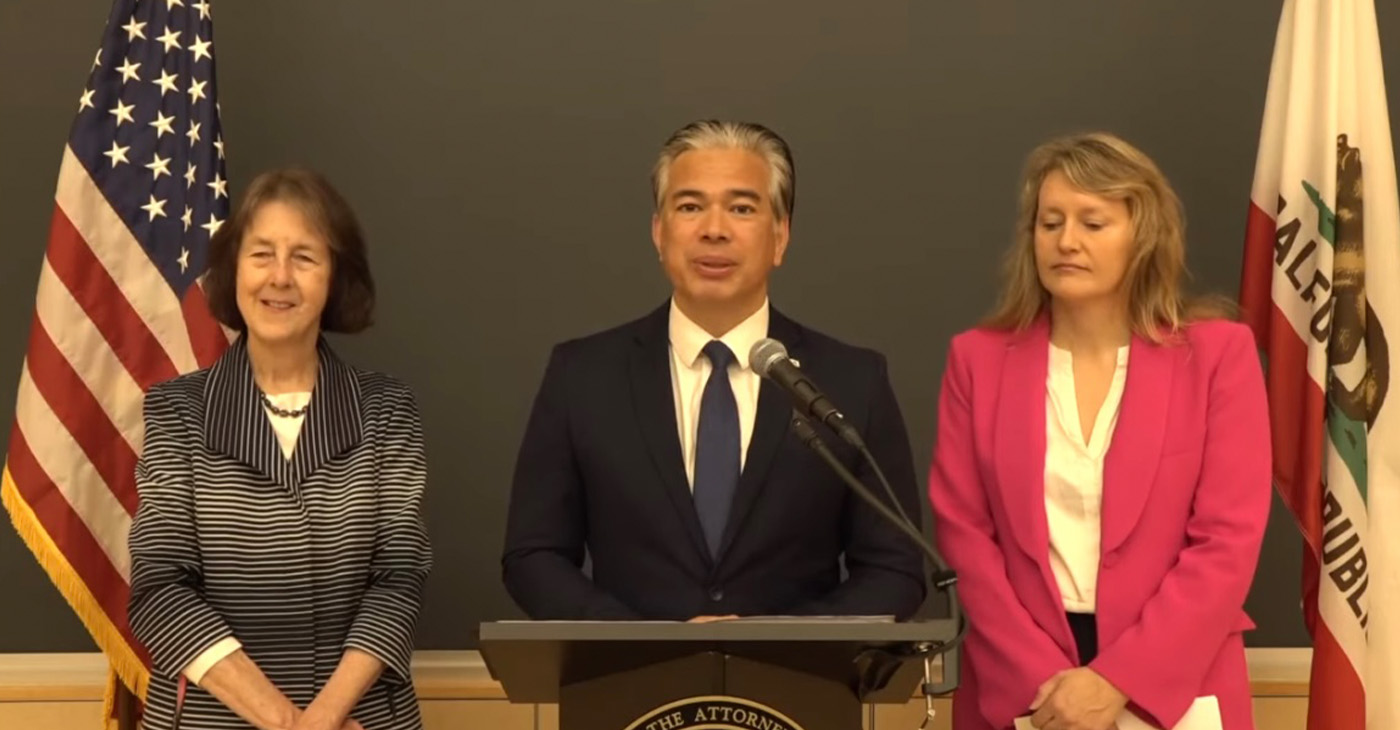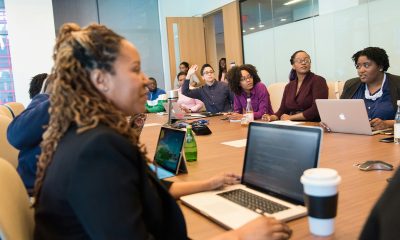Technology
Online Common Core Testing Lays Bare Tech Divide in Schools

In this April 30, 2015 photo, Leticia Fonseca, 16, left, and her twin sister, Sylvia Fonseca, right, work in the computer lab at Cuyama Valley High School after taking the new Common Core-aligned standardized tests in New Cuyama, Calif. The Cuyama Joint Unified School District is 60 miles from the nearest city and has Internet connections about one-tenth the minimum speed recommended for the modern U.S. classroom. Across the country, school districts in rural areas and other pockets with low bandwidth are confronting a difficult task of administering new Common Core-aligned standardized tests to students online. (AP Photo/Christine Armario)
CHRISTINE ARMARIO, Associated Press
SALLY HO, Associated Press
NEW CUYAMA, Calif. (AP) — Nestled between mountains 60 miles from the nearest city, students at Cuyama Valley High School use Internet connections about one-tenth the minimum speed recommended for the modern U.S. classroom.
So when it came time to administer the new Common Core-aligned tests online, the district of 240 students in a valley of California oil fields and sugar beet farms faced a challenge.
New Cuyama has no access to fiber optic cables. Some residents live entirely off the grid, relying on solar power and generators. The local telephone company provided a few extra lines, but that only bumped speeds a few megabits.
“We tripled our capacity but it’s still woefully inadequate,” said Paul Chounet, superintendent of the Cuyama Joint Unified School District.
Across the country, school districts in rural areas like New Cuyama and other pockets with low bandwidth are confronting a difficult task: Administering the new standardized tests to students online, laying bare a tech divide in the nation’s classrooms.
Overall, 63 percent of public schools don’t have access to broadband speeds needed for digital learning. The problem is particularly acute in rural and low-income districts: Only 14 percent in those areas meet high-speed internet targets.
“It’s just very uneven all over the country,” Lan Neugent, executive director of the non-profit State Educational Technology Directors Association.
The Federal Communications Commission approved a $1.5 billion spending cap increase for school broadband and Wi-Fi last year that is expected to significantly boost connectivity. State grants linked to Common Core implementation and collaborations with tech and business leaders are also bridging the gap. But those initiatives could take a year or more to connect thousands of schools and testing started in 29 states and the District of Columbia for 12 million students this year.
In the meantime, they’re resorting to alternatives: Testing students in small groups, busing them to other schools and limiting all other internet access while exams are taken.
On a recent testing day in New Cuyama, 11 students filed into the high school’s small computer lab. Even with such a small number of test takers, students said they’d gotten kicked offline and had to log in again.
“It got me off track,” said Brian Olivas, 17.
The Common Core standards adopted in 43 states and the District of Columbia provide uniform benchmarks for what students should know in each grade in reading and math. To aid their adoption, two groups of states received grants from the U.S. Department of Education to develop new assessments required to be computer based.
By administering the tests online, educators can test more skills. Students can be asked, for example, to demonstrate how they would conduct a science experience or solve a math problem, rather than just bubble in an answer.
Some states were already administering their tests by computer. The vast majority, however, had to quickly bring their technology and infrastructure up to speed.
A survey by the Center for Education Policy found most districts had concerns about hardware and internet speeds and more than half said they didn’t expect to have the technology infrastructure in place to administer the test until this year or later.
The tech challenges come as the Common Core standards and testing face continued resistance. Thousands of parents in New York and a handful of other states chose to opt their children out of the new exams this year. And the standards have already become fodder for the 2016 presidential elections, with early Republican contenders like senators Marco Rubio and Ted Cruz dismissing them as a federal intrusion forced on students, even though they were adopted by states.
Ideally, technology can help eliminate achievement gaps between poor and rural students and their more affluent peers. The shift to online testing, however, reveals how wide the digital divide remains. Districts like Chicago Public Schools with large numbers of low-income students have raised questions about whether their students — who often don’t have access to a computer or the Internet at home — are at a disadvantage.
“The implementation of Common Core is bringing these issues more to the forefront,” said Ryan Smith, executive director of the nonprofit Education Trust-West. “But this has been an issue that has plagued communities of color and low income communities for years.”
Nevada, Montana and North Dakota all dealt with crippling outages at the hands of their test maker, Measured Progress and Smarter Balanced consortium, believed to be linked to a server capacity issue traced down to initial coding problems. Florida, Colorado, New Jersey and other states also experienced glitches.
In light of those issues, some districts have resorted to the paper test.
In New Cuyama, Chounet expects to get internet speeds up to the recommended 100 megabits per second by next year with the help of a state grant that will connect schools to higher bandwidth.
Chounet said those updates can’t come quick enough.
“Even though we’re isolated we have to provide students the technology skills,” he said. “When they leave here, that’s going to be the expectation.”
_
Associated Press writer Sally Ho reported from Las Vegas.
_
Follow Christine Armario on Twitter: http://www.twitter.com/cearmario
Follow Sally Ho on Twitter: http://twitter.com/1sallyho
Copyright 2015 The Associated Press. All rights reserved. This material may not be published, broadcast, rewritten or redistributed.
Community
Attorney General Rob Bonta, Oakland Lawmakers, Introduce Legislation to Protect Youth Online
At a press conference in downtown Oakland on Jan. 29, Attorney General Rob Bonta joined Sen. Nancy Skinner (D-Berkeley) and Assemblymember Buffy Wicks (D-Oakland) to announce two pieces of legislation designed to protect children online. The bills are Senate Bill (SB) 976, the Protecting Youth from Social Media Addiction Act and Assembly Bill (AB) 1949, the California Children’s Data Privacy Act.

By Magaly Muñoz
At a press conference in downtown Oakland on Jan. 29, Attorney General Rob Bonta joined Sen. Nancy Skinner (D-Berkeley) and Assemblymember Buffy Wicks (D-Oakland) to announce two pieces of legislation designed to protect children online.
The bills are Senate Bill (SB) 976, the Protecting Youth from Social Media Addiction Act and Assembly Bill (AB) 1949, the California Children’s Data Privacy Act.
Skinner authored SB 976, which addresses online addiction affecting teenage users, while Wicks’s bill, AB 1949, takes on big tech by proposing data privacy and children rights protections.
“Social media companies unfortunately show us time and time again that they are all too willing to ignore the detriment to our children, the pain to our children, the mental health and physical challenges they face, in order to pursue profits,” Bonta said.
SB 976 would allow parents to control the nature and frequency of the content their under-18-year-old children see on social media. Notifications from social media platforms would also be paused from midnight to 6 am and controls would allow parents to set time limits on their children’s usage based on their discretion.
Skinner stated that the longer that kids are on their phones during the day, the higher the risk for depression, anxiety and other related issues.
The bill would also push to get rid of addictive media that is harmful for young women and girls, specifically image filters that mimic cosmetic plastic surgery.
Bonta and 33 other attorney generals had previously filed a lawsuit against Meta, owner of the popular social media applications Instagram and Facebook. The filing claims that the company purposefully uses algorithmized content that harms younger audiences.
“Social media companies have the ability to protect our kids, they could act, but they do not,” Skinner said.
The Child Data Privacy Act would strengthen existing protections for data privacy under the California Consumer Privacy Act (CCPA). The lawmakers argue that the law does not have effective protection for those under 18 years old.
Wicks stated that the bill would forbid businesses from collecting, using, sharing, or selling personal data of anyone underage unless they receive informed consent, or it becomes necessary for the purpose of the business.
Wicks added that the acts would make it so that a search on the internet like “How do I lose weight?” would not result in dieting pill advertisements targeting youth, which, some experts report, could be harmful to their mental and physical health.
“In a digital age where the vulnerabilities of young users are continually exploited, we cannot afford to let our laws lag behind, our children deserve complete assurance that their online experience will be safeguarded from invasive practices,” Wicks said.
Supporters of the two acts say they have gained bipartisan support issue, but the authors and Bonta expect them to be met with pushback from the affected companies.
#NNPA BlackPress
Unleashing the Power_ Discover the The Thrills…F-TYPE Convertible
Performance & Handling Powered by a robust 5.0 Liter Supercharged 8 Cylinder Gas Engine, the F-Type R75 doesn’t just purr; it roars with a mighty 575 horsepower and 516 lb-ft of torque. Coupled with an 8-speed Automatic Transmission, the car offers an exhilarating drive that is both fast and smooth. The All-Wheel Drive system ensures […]
The post Unleashing the Power_ Discover the The Thrills…F-TYPE Convertible first appeared on BlackPressUSA.

Performance & Handling
Powered by a robust 5.0 Liter Supercharged 8 Cylinder Gas Engine, the F-Type R75 doesn’t just purr; it roars with a mighty 575 horsepower and 516 lb-ft of torque. Coupled with an 8-speed Automatic Transmission, the car offers an exhilarating drive that is both fast and smooth. The All-Wheel Drive system ensures excellent traction and stability, making it a joy to handle in various driving conditions. The Electric Power Assisted Steering and JaguarDrive Control with Selectable Driving Modes add to the car’s agility, providing a driving experience that is as intuitive as it is thrilling. Additionally, the Adaptive Dynamics and Electronic Active Differential with Torque Vectoring by Braking enhance the car’s responsiveness, making every turn a testament to its engineering prowess. Unique to AutoNetwork.com.
with Selectable Driving Modes add to the car’s agility, providing a driving experience that is as intuitive as it is thrilling. Additionally, the Adaptive Dynamics and Electronic Active Differential with Torque Vectoring by Braking enhance the car’s responsiveness, making every turn a testament to its engineering prowess. Unique to AutoNetwork.com.
Like us on and share https://www.facebook.com/autonetwork
#AutoNetwork
#AutoNetworkReports
Subscribe to our channel now for more videos.
Twitter http://www.twitter.com/liveautos
LinkedIn http://www.linkedin.com/in/autonetwork
Coupons Offers and Deals https://www.couponsoffersanddeals.com/
The post Unleashing the Power_ Discover the The Thrills…F-TYPE Convertible first appeared on BlackPressUSA.
#NNPA BlackPress
Elevate Your Ride…
Join us for a virtual car’s best-detailed walkaround of the sleek and stylish 2024 Jaguar F-TYPE AWD convertible. Get an up-close look at the exterior design, interior features, and performance capabilities of this luxury sports car. From its powerful engine to its advanced technology, this video will give you a comprehensive overview of what makes […]
The post Elevate Your Ride… first appeared on BlackPressUSA.

Join us for a virtual car’s best-detailed walkaround of the sleek and stylish 2024 Jaguar F-TYPE AWD convertible. Get an up-close look at the exterior design, interior features, and performance capabilities of this luxury sports car. From its powerful engine to its advanced technology, this video will give you a comprehensive overview of what makes the F-TYPE AWD convertible stand out on the road. Unique to AutoNetwork.com.
Like us on and share https://www.facebook.com/autonetwork
#AutoNetwork
#AutoNetworkReports
Subscribe to our channel now for more videos.
Twitter http://www.twitter.com/liveautos
LinkedIn http://www.linkedin.com/in/autonetwork
Coupons Offers and Deals https://www.couponsoffersanddeals.com/
The post Elevate Your Ride… first appeared on BlackPressUSA.
-

 Activism4 weeks ago
Activism4 weeks agoOakland Post: Week of March 20 – 26, 2024
-

 #NNPA BlackPress3 weeks ago
#NNPA BlackPress3 weeks agoCOMMENTARY: D.C. Crime Bill Fails to Address Root Causes of Violence and Incarceration
-

 #NNPA BlackPress4 weeks ago
#NNPA BlackPress4 weeks agoFrom Raids to Revelations: The Dark Turn in Sean ‘Diddy’ Combs’ Saga
-

 #NNPA BlackPress3 weeks ago
#NNPA BlackPress3 weeks agoMayor, City Council President React to May 31 Closing of Birmingham-Southern College
-

 #NNPA BlackPress4 weeks ago
#NNPA BlackPress4 weeks agoCOMMENTARY: Lady Day and The Lights!
-

 Activism3 weeks ago
Activism3 weeks agoOakland Post: Week of March 27 – April 2, 2024
-

 #NNPA BlackPress4 weeks ago
#NNPA BlackPress4 weeks agoBaltimore Key Bridge Catastrophe: A City’s Heartbreak and a Nation’s Alarm
-

 #NNPA BlackPress4 weeks ago
#NNPA BlackPress4 weeks agoBaltimore’s Key Bridge Struck by Ship, Collapses into Water















































